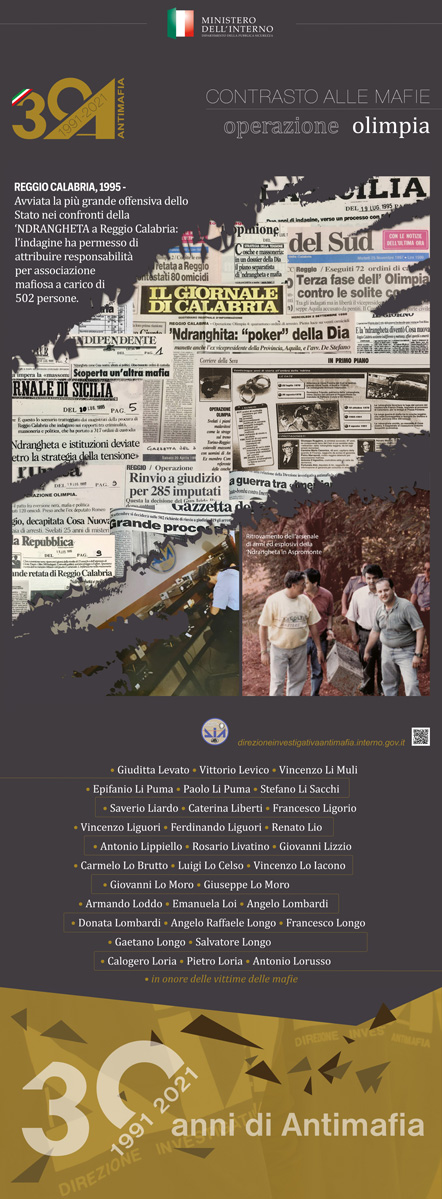

OPERATION “OLIMPIA”
Considered the largest offensive by the Italian State against the ‘Ndrangheta, operating in the province of Reggio Calabria, the Police operation “Olimpia” was the result of the investigations conducted further to the statements of numerous collaborators of justice.
The investigations, carried out on 563 people, allowed revealing, for the first time, the assets and structures of almost all the Mafia families and clans operating in Central Italy as well as the relationships with those operating in the Ionian and Tyrrhenian area. This operation allowed accurately reconstructing the bloodiest events, involving the two opposing sides, the so-called “destefaniani” and “imertiani-condelliani, at the time of the first signs announcing the so-called first Mafia war (1974-1977) up to the “pax mafiosa“. The pax was reached after the intervention by the powerful families of Alvaro, “imertiana“, and Nirta, “destefaniana“, subsequent to the second Mafia war (1985-1991), coinciding with the murder of Judge Antonio Scopelliti.
Overall, precise responsibilities emerged in relation to 502 people, belonging to the ‘Ndrangheta, members of 20 clans, who were charged with the crimes of Mafia-type association, armed association, murder, drug trafficking, arms trafficking, extortion, theft, robbery, handling of stolen goods, bribery and other offences.
The investigations, coordinated by the local Anti-Mafia Prosecutor’s Office (DDA) of Reggio Calabria and carried out by the local DIA Field Office, allowed establishing the exact structure of the opposing clans and identifying ascertained responsibilities in relation to 148 murders. In this connection, a historical reconstruction of full value was carried out revealing, among other things, the real reasons – referable typically to the Mafia “logic” – for which the opposing clans faced each other in the two Mafia wars, as well as providing the interpretation of the numerous murders.
In particular, at the beginning of the 1970s, an unfair sharing out of a consignment of contraband cigarettes, carried out by the DE STEFANO clan to the detriment of the undisputed and dominant TRIPODO family, created a break in the Mafia power balances. This break, although resolved with the murder of DE STEFANO Giorgio, saw just the brother of the victim, DE STEFANO Paolo, as the winner of the first Mafia war.
Instead, two brutal acts of violence marked the break of the unity achieved, causing the second Mafia war: the attempted murder, committed on 10.10.1985, against the bosses IMERTI Antonino and BUDA Natale, through the explosion of a car bomb and, three days later, the immediate reaction, killing the boss DE STEFANO Paolo in the undisputed domain of the “Archi” district in Reggio Calabria.
The investigations allowed throwing light on an alarming ‘Ndrangheta top-down structure at the provincial level, capable of coordinating the activities of all the “locali” expanded in the national and international territory. This structure was in charge of maintaining important relations with the other Mafia-type associations of the Camorra and Cosa Nostra, as well as dangerous subversive connections with fringes of the extreme right (to which the attack on the rapid train 904, carried out in July 1970 in Gioia Tauro, is to be attributed), deviant individuals from the Freemasonry, Intelligence Services, Law enforcement authorities and political representatives of the Italian institutions.
The information emerged from the complex activity carried out by the Judicial Authority of Reggio Calabria was summarized by the local DIA Field Office which drew up 60 volumes. This outlined in-depth the reasons of the latent conflict between various ‘Ndrangheta families, since 1969, shedding light on 360 blood crimes committed during the Mafia war, revealing detailed information on the criminal structures which operated in the regional capital of Reggio Calabria and in its neighboring municipalities.
Without a doubt, it was the most horrendous chain of murders committed in such a short time. They terrorized the entire local community due to the extraordinary firepower deployed, using military weapons and a large number of armored cars, as well as the availability of unscrupulous killers and armed groups having inexorable operational capacity.
The judicial action also succeeded in striking those sophisticated mechanisms of extortion that, thanks to a widespread climate of intimidation, the clans put in place both in order to control the territory and to take over businesses and financial assets, related to the immense illicit ‘Ndrangheta property. This has given to the Mafia organizations a vast economic power and, consequently, a great influence over the social economy.
Overall, a well-tested system to collect bribes was brought to light, revealing the personal responsibilities for as many as 63 extortion conducts, considering the ascertained existence of a sole top-down structure in which all the proceeds from extortion poured, subsequently redistributed, on the basis of fixed criteria, to the various bosses of the “locali“. Clearly, the achievement of this agreement took place only after the “pax mafiosa” (in July-August 1991) which had allowed, effectively, further planning that criminal activity.
The investigations also revealed the ramifications of the Calabrian criminal organization in the territories outside the region and abroad, shedding light on their interests, trafficking, structures, area of influence and modus operandi. In this regard, it has been ascertained that, also through the collaborators of justice statements, the official modalities for the affiliation and oath of the clan members operating above all in Lombardy as well as their assumption of “offices” and “progress in jobs” were similar with the existing and well-established ceremonies in Calabria. For the first time, it was possible to demonstrate that, within the ‘Ndrangheta, there was a body hierarchically higher than each single clan, based on a control structure in force under the Mafia criminal scheme in Sicily (so-called Provincial Commission).



